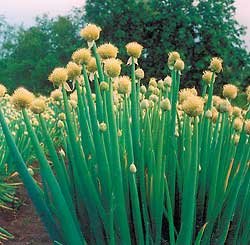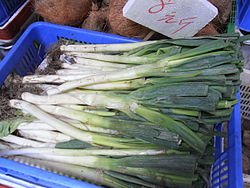Welsh Onion
 Common Names: Welsh onion, spring onion (Japanese) bunching onion, long green onion, scallion
Common Names: Welsh onion, spring onion (Japanese) bunching onion, long green onion, scallion
Scientific Name: Allium fistulosum
Climate: Cold and warm
Plant Description: The Welsh onion is a herbaceous perennial plant. It produces between two and ten hollow, cylindrical stalks, which are about 30-50 cm long. They grow from a long underground bulb, although it is sometimes referred to as a bulbless onion. The plant grows in clusters. Flowers grow in bunches of up to 100 at the end of the stalk. Unlike the common onion, the Welsh variety does not have a very strong smell. All parts of the plant are edible although the leaves are probably more popular.
Cultivation: Welsh onions can be easily propagated by separating plants from the main bunch. It can adapt to a wide range of soils and growing conditions. However, it grows best in well-drained soils, rich in organic material. It is a cold-resistant plant. In tropical climates, it can be cultivated at altitudes of between 1000 - 2000 m. In such climates, it is almost never grown from seed although this is possible in more temperate climates, where the seed can be planted directly in the field. Seeds take about a week to ten days to sprout. Welsh onions are best planted in spring.
Welsh onions should be planted about 10 cm apart with a distance of about 30 cm between rows because they tend to cluster a lot. Mulch between rows retains moisture and controls weeds. If mulch is used, they do not require constant watering. As with other members of the allium family, it is important to get the balance right because too much water can lead to fungal growth and too little can cause poor bulb growth. They should be irrigated to a depth of about 2.5 cm once a week rather than daily sprinkling.
Like other varieties of onions, they grow best in direct sunlight. Compost should be added to the soil before planting to ensure a rich soil. Crop rotation is a good way of preventing the spread of diseases that commonly affect the onion family, so they should not be planted in the same place continuously.
Welsh onions take about three months to fully grow and to be ready for harvesting. The leaves can be cut leaving the bulbs in the ground, or the whole plant can be pulled from the soil as all parts of the plant are edible. They will stay fresh for about two weeks after harvesting. Although the plant may die back completely in colder climates, it will grow back.
 Uses: Both bulbs and leaves of Welsh onions can be eaten raw or cooked in salads and soups and they are a popular ingredient for flavoring many dishes. They are high in vitamins B, C, and K, minerals (magnesium, potassium and sulphur), antioxidants, fiber, and low in calories.
Uses: Both bulbs and leaves of Welsh onions can be eaten raw or cooked in salads and soups and they are a popular ingredient for flavoring many dishes. They are high in vitamins B, C, and K, minerals (magnesium, potassium and sulphur), antioxidants, fiber, and low in calories.
The high vitamin C content in Welsh onions helps boost the immune system. Vitamin C also facilitates digestion. There are indications that it can prevent illness and infection and produces antibodies that combat flu. The high levels of vitamin K aid blood flow, prevent thickening of arteries, and reduce the risk of heart attack. The sulphur contained in onions also assists in building cells. Finally, there are indications that it reduces the risk of certain cancers that affect the digestive tract.
They act as an effective insect repellent and grow well with most plants, especially with carrots. However, they can inhibit the growth of legumes and should not be planted with alfalfa as these two plants negatively affect each other.
Pests and Diseases: The Welsh onion is a healthy crop that is not affected by many pests or diseases. Nevertheless, it can be affected by those that attack other plants of the allium family. The main pest is the onion fly, which can be partly avoided by ensuring that it is not cultivated near the common onion. Good soil management and careful irrigation are key to preventing fungi.
References:
http://tropical.theferns.info/viewtropical.php?id=Allium+fistulosum
https://uses.plantnet-project.org/en/Allium_fistulosum_(PROTA)
https://www.healthbenefitstimes.com/scallion/
https://www.sciencedaily.com/releases/2019/02/190221095057.htm
En español: Cebolla cambray
